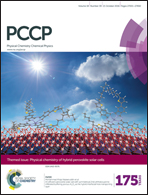Domain-dependent electronic structure and optical absorption property in hybrid organic–inorganic perovskite†
Abstract
Hybrid organic–inorganic perovskites, represented by materials in the CH3NH3PbI3 series, have become one of the most promising materials for solar cells with a high power conversion efficiency and low cost. The ordered Pb–I cage in such hybrid perovskites can induce the polarized cations to form a variety of polarization domains with long-range order, which will lead to the formation of specific atomic conformations or metastable crystalline phases, unique electronic band structures and optical absorption properties. Such domain-dependent characteristics play a critical role in the phase transition and service stability of such solar cells, and also open up the opportunity of tuning their electronic structure. In the present study, we systematically investigate the band structures and optical absorption properties of different electronically ordered domains in CH3NH3PbI3. By comparing different perovskites containing various cations, we have clarified the important influence of cation polarization on domain-dependent properties. Our results provide not only a possible pathway for the manipulation of band structure by applying an external field, but also a novel scheme for improving the performance and stability of hybrid perovskites.


 Please wait while we load your content...
Please wait while we load your content...